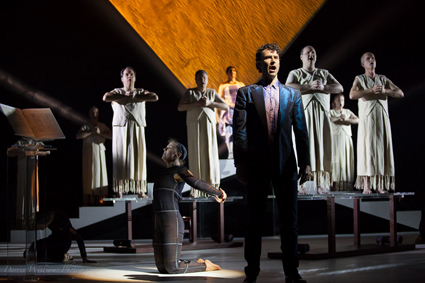Opera redux: the Glass Trilogy
Chris Reid: State Opera of SA, Philip Glass Operas

Philip Glass Trilogy, Akhnaten
photo Darren Williams, courtesy State Opera of SA
Philip Glass Trilogy, Akhnaten
Though considered radically experimental when first produced, Philip Glass’s early operas have become standard repertoire because of their enduring musical strength and originality. Glass’s initial three—Einstein on the Beach (co-written with director Robert Wilson and choreographer Lucinda Childs, 1976), Akhnaten (1980) and Satyagraha (1983)—form what he called a portrait trilogy, paying homage to significant figures: Einstein the physicist, Mahatma Gandhi the civil rights champion and Akhnaten, the Egyptian pharaoh who revolutionised religious belief during his reign, all legendary figures who have god-like status.
But these operas are not conventional theatrical stories—Einstein on the Beach is not a story at all, but a choral, instrumental and dance performance with spoken texts addressing contemporary society.
It was with Einstein on the Beach that Glass and Wilson broke new ground, introducing a unique kind of formalism into the territory of conservative opera culture. Wilson had previously created theatre pieces of many hours’ or even days’ duration, dissolving the barrier between theatre and life. Einstein on the Beach is intended to run four–five hours without a break, during which the audience can come and go. But in its 2014 production, State Opera SA breaks it into four discrete acts, each of 50 minutes, with intervals, while still retaining the five “knee plays” linking the four acts. State Opera has reinvented Einstein on the Beach, retaining its essential character while enabling a high level of concentrated performance by the dancers and singers. Importantly, it changes the dynamic for the audience, so that instead of the opera appearing as one long immersion with which you interact as you wish, you now focus on the four parts. The result is breathtakingly intense.
State Opera does not use the original set design. Nor is the violinist, the wonderful Carolyn Lam, who also doubles on keyboard, dressed as Einstein but is instead seated with the other musicians centre-stage—except when she briefly engages in a dance passage while playing. Thus we hear but don’t see the figure of Einstein. State Opera’s design is spare, emphasising the dancers and the music while reducing visual cues to essentials. The central visual feature is a huge floating black triangular form that hovers above the performers.
The highlight of the trilogy is dancer Rebecca Jones’ performance in Einstein on the Beach, superbly delivering the Supermarket speech while en pointe. Her exquisite execution of classical ballet moves is in startling contrast to her rumination on mundane urban life—she’s a creative soul searching for meaning. The choreography throughout Einstein is superb, as the dancers move around the stage in close proximity to the musicians, as if feeding off the music. The five musicians form a central visual element, as does Timothy Sexton’s conducting, which links all the movement on stage to the complex musical structure with mathematical precision.
The State Opera Chorus is the driving force in all three operas. Producing a peerless sound, their controlled, tireless repetition of Glass’s musical figures creates hypnotic rhythms, building a chant that overwhelms all other thought, as if music represents the laws of physics governing the universe. As the musical patterns repeat and mutate, we are reminded of the repeating behaviours that characterise life on Earth and its evolution. In Einstein, the chorus repeats the solfege scale or a series of numerals as if they are mantras. The three operas are meditations and an education in the appreciation of mathematical complexity rendered as music. Throughout the trilogy, Sexton directs both musicians and chorus, managing entrances and multiple rhythms. The musicians are superb, brilliantly rendering Glass’s music. Vocal soloists Adam Goodburn (an excellent Ghandi), Cherie Boogaart and Deborah Caddy are outstanding, all having roles in both Akhnaten and Satyagraha in the same week.
State Opera’s most significant move in producing this trilogy is in inviting choreographer Leigh Warren to direct. Dance is a central element of Einstein, and Warren also recreates Akhnaten and Satyagraha through some wonderful choreography. In Akhnaten, the black-clad dancers swirl around the white-robed chorus and the soloists who are in contemporary western clothes. The dancers appear as a life force, their vitality and suppleness contrasting the measured, ritualised movement of the soloists.
Again in Satyagraha (the word refers to non-violent protest), the dancers envelop the singers in movement representing turbulent human and cosmic forces, or they become crowds or mimic forms such as lotus flowers opening. The most conventional of the operas, Satyagraha is exquisitely slow. There is a narrative element but the music, the singing (in Sanskrit) and the dance overwhelm it—unlike the other two operas, there is no outline in the program notes, implicitly inviting us to treat Satyagraha as a visual and musical experience to be appreciated rather than a story to be understood.
While thematically the operas represent science, politics and religion, the overarching framework becomes religion, or rather a raised level of spiritual consciousness. Refraining from any didactic or evaluative position, the operas are a celebration of three ideal, heroic figures. This trilogy is the core of Glass’s oeuvre, and through their musical linking, the three operas appear as a single work that is greater than the sum of the parts. Staging the three so successfully is a huge achievement.
State Opera of SA, Philip Glass Trilogy: Akhnaten, Einstein on the Beach, Satyagraha, director, choreographer Leigh Warren, director, conductor, chorus master Tim Sexton, Leigh Warren Dancers, Adelaide College of the Arts Dance Ensemble, Members of the Adelaide Symphony Orchestra and Adelaide Art Orchestra, designer Mary Moore, lighting Geoff Cobham; Her Majesty’s Theatre, Adelaide, 5, 7, 9 Aug
RealTime issue #123 Oct-Nov 2014 pg. 46






